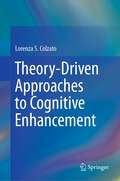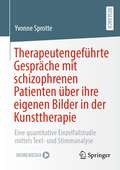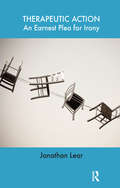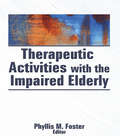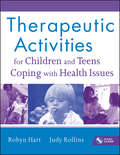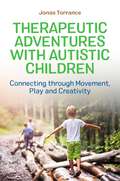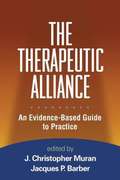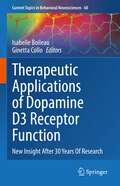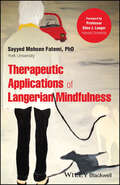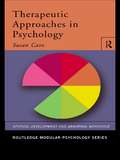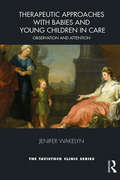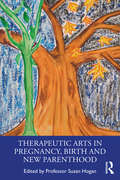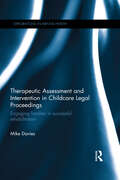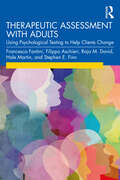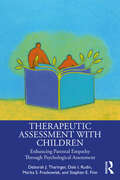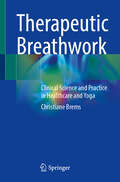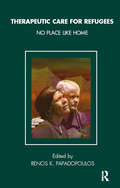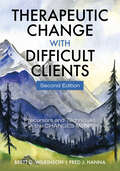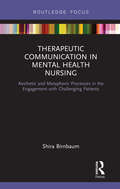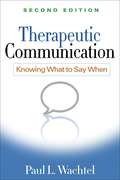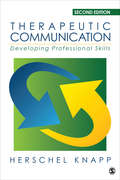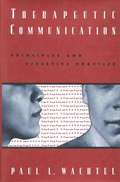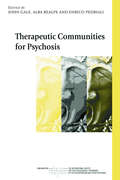- Table View
- List View
Theory-Driven Approaches to Cognitive Enhancement
by Lorenza S. ColzatoThis book provides a comprehensive overview of cognitive enhancement, the use of different substances and actions (e. g. , meditation, video game, smart drugs, food supplements, nutrition, brain stimulation, neurofeedback, physical exercise, music, or cognitive training) to enhance human perception, attention, memory, cognitive control, and action in healthy individuals. Chapters contain research on enhancing procedures and activities that will help to further develop enhancement based on individual needs and interests. Chapters also discuss the underlying mechanism of how these means influence and change behaviors and moods. In addition, the book also provides "real-life" examples in which the several means of cognitive enhancement have been successfully applied. It concludes with a call to develop more specific, mechanistic theories to guide cognitive enhancing programs as well as the editor's own tailored-approach proposal for enhancing cognition for individuals. Featured topics include: The effect of caffeine on cognitive abilities. Aerobic exercise and its short-term and long-term effects on cognition. The effect, if any, of Ritalin and Modafinil on promoting cognitive enhancement. Temperature variations and its influences on behavior. The effect of food supplements across the lifespan. "Theory-Driven Approaches to Cognitive Enhancement is a must-have resource for psychologists, physicians, sport and exercise scientists, medical scientists, and teachers". "This book provides a state-of-the-art overview of different aspects of cognitive enhancement. The chapters are very focused, well-structured, in-depth, and rounded up by excellent illustrations. I highly recommend the book to readers interested in the matter". Dr. Julia Karbach, Goethe University "It is overall a highly original book on a timely topic, with a fresh approach and rich in practical and societal implications. The book is written in a very clear way and it is a pleasure to read. " Dr. Anna M. Borghi, Sapienza University of Rome
Therapeutengeführte Gespräche mit schizophrenen Patienten über ihre eigenen Bilder in der Kunsttherapie: Eine quantitative Einzelfallstudie mittels Text- und Stimmanalyse
by Yvonne SprotteAnhand einer explorativen Studie an Patienten mit chronischen Verlaufsformen der Schizophrenie wird in diesem Buch untersucht, ob eine Gruppen-Kunsttherapie mit anschließender Bildbesprechung das Kommunikationsverhalten der Patienten beeinflussen kann. Als potenzielle Indikatoren für das Kommunikationsverhalten werden Merkmale der Stimme und Sprache gewählt, die mit objektiven technischen Analyseverfahren erfasst werden. Sieben Patienten nahmen über einen Zeitraum von sechs Monaten an einer wöchentlichen Kunsttherapie in der Gruppe teil. Hier waren sie bildnerisch tätig. Im Einzelinterview nach drei bis vier Tagen sprachen sie dann mit der Autorin über ihr eigenes Bild, und zwar in Form eines standardisierten Leitfadeninterviews, das digital aufgezeichnet wurde. Die Audiodokumente werden mit validierten computergestützten Analyseverfahren ausgewertet; es werden Veränderungen bei Stimmanalyse-Faktoren gemessen, die eine Aktivierung von Emotionen belegen. Sie lassen sich naheliegend als Ergebnis eines kathartischen Heilungsprozesses interpretieren. Die in dieser Studie vorgestellten Methoden haben das Potenzial, einen wesentlichen Beitrag zur quantitativen Erforschung der Wirksamkeit und Wirkweise der Kunsttherapie zu leisten.
Therapeutic Action: A Guide to Psychoanalytic Therapy
by Enrico E. JonesDiscusses the Q-sort method for quantifying and tracking progress in psychotherapy.
Therapeutic Action: An Earnest Plea for Irony
by Jonathan LearThis book discusses how to write about the process of psychic change without betraying either love or science. It investigates the concepts of subjectivity and objectivity that are appropriate for psychoanalysts, the concepts of internalization and of transference.
Therapeutic Activities With the Impaired Elderly
by Phyllis M. FosterThis highly practical volume presents valuable insights for all professionals who provide activities for the impaired elderly. It will serve as a helpful resource for both those who work directly with the aged in institutional settings, as well for those who train activities counselors.Therapeutic Activities With the Impaired Elderly addresses a number of pertinent issues and provides useful information on designing and implementing recreation and socialization programs, memory improvement classes, sign language activities, and leisure education and counseling.
Therapeutic Activities for Children and Teens Coping with Health Issues
by Judy Rollins Robyn HartBuilding on children's natural inclinations to pretend and reenact, play therapy is widely used in the treatment of psychological problems in childhood. This book is the only one of its kind with more than 200 therapeutic activities specifically designed for working with children and teenagers within the healthcare system. It provides evidence-based, age-appropriate activities for interventions that promote coping. The activities target topics such as separation anxiety, self-esteem issues, body image, death, isolation, and pain. Mental health practitioners will appreciate its "cookbook" format, with quickly read and implemented activities.
Therapeutic Adventures with Autistic Children: Connecting through Movement, Play and Creativity
by Jonas TorranceA vivid exploration of working with autistic children using empowering techniques from a range of creative therapies. Each chapter in this heartening book is the story of a child with autism and how therapy was pivotal in confronting his or her individual dilemma. Covering many of the behaviours characteristic to autism, such as uncontrolled anger and obsessive tendencies, the therapies used range from drawing and dancing to meditation and martial arts, depending on the needs and interests of each child. The key message is that investing in the relationship between the therapist and the child - so that they grow, play and develop together - is transformative.
Therapeutic Alliance
by Jacques Barber J. MuranThis state-of-the-art book presents research-based practice guidelines that clinicians of any orientation can use to optimize the therapeutic alliance. Leading proponents of the major psychotherapeutic approaches explain just what a good alliance is, how to create it, and how to recognize and repair alliance ruptures. Applications in individual, group, couple, and family therapy are explored; case examples vividly illustrate the concepts and techniques. Links between the quality of the alliance and client outcomes are elucidated. A section on training fills a major gap in the field, reviewing proven strategies for helping therapists to develop key relationship-building skills.
Therapeutic Applications of Dopamine D3 Receptor Function: New Insight After 30 Years Of Research (Current Topics in Behavioral Neurosciences #60)
by Isabelle Boileau Ginetta ColloThe CTBN volume Therapeutic Applications of Dopamine D3 Receptor Function reviews the state of the knowledge on the dopamine D3 receptor and its role in human behavior and disease (i.e.: neuropsychiatric illnesses including schizophrenia, mood disorders, Parkinson’s disease, restless legs syndrome, addictions and substance use disorders). The volume is written by leading experts across multidisciplinary areas (imaging, biobehavioral testing and clinical trials, preclinical models / molecular pharmacology) converging on the therapeutic implications / potential of the D3 receptor.The D3 dopamine receptor is a member of the D2-like family of G protein-coupled receptors. It was cloned and characterized almost 25 years ago. A key feature of the D3 dopamine receptor system, which has attracted considerable attention, is its anatomical localization remarkably restricted to the limbic circuitry. This has spurred the hypothesis that D3 involvement could contribute to the pathophysiology of neuropsychiatric disorders (or to some features of neuropsychiatric disorders), including but not limited to psychosis, addictions and substance abuse, mood and movement disorders.
Therapeutic Applications of Langerian Mindfulness
by Sayyed Mohsen Fatemi Ph.D.Therapeutic Applications of Langerian Mindfulness Explore an authoritative new treatment of Langerian mindfulness Therapeutic Applications of Langerian Mindfulness delivers a collection of novel psychotherapeutic techniques grounded in Langerian mindfulness for dealing with psychological problems. The author draws on empirically grounded psychological research to demonstrate new approaches to fostering creativity and novelty in the reader or the reader’s patients. The book includes practical exercises that allow the reader to apply the concepts and techniques discussed within to help them manage anxiety, relationships, creativity, and productivity and performance. It also includes: A thorough introduction to Langerian mindfulness and how it differs from meditation-based mindfulness Practical discussions of the relationship between mindfulness, anxiety, and depression, as well as the key strategies for dealing with anxiety and depression with Langerian mindfulness Comprehensive explorations of mindfulness and agency, as well as the relationship between agency and wellness In-depth examinations of the phenomenological configuration of mindfulness, including discussions of the psychology of presence Perfect for mindfulness practitioners and enthusiasts in both lay and professional audiences, Therapeutic Applications of Langerian Mindfulness is an indispensable resource for therapists and practitioners seeking a one-stop reference on Langerian mindfulness. “In Therapeutic Applications of Langerian Mindfulness, Professor Sayyed Mohsen Fatemi provides clear and concrete examples of how Langerian mindfulness both liberates and heals. Basing his reflections on the inspiration of his mentor, Professor Ellen Langer, Fatemi shows in brilliant, methodical chapters the range of ways this mindfulness approach can transform lives. In the end, what both Langer and Fatemi stress is the power of attitude to make remarkable shifts in our capacity for mental and physical wellbeing. Whereas an attitude of mindfulness opens the world to virtually inexhaustible possibilities, an attitude of mindlessness—or what I call the polarized mind—shuts this process down entirely, and is one of the pivotal bases for the decay we see today, both in individuals and the societies that bear them.” — Kirk J. Schneider, PhD, author of The Polarized Mind, The Depolarizing of America, Awakening to Awe, and most recently Life-Enhancing Anxiety: Key to a Sane World “This book provides an in-depth practical analysis of cutting-edge research on Langerian mindfulness and offers promising techniques on healing, wellbeing, and growth.” —Ellen J. Langer, Harvard University
Therapeutic Approaches in Psychology (Routledge Modular Psychology)
by Sue CaveTherapeutic Approaches in Psychology is a simple introduction to the many psychological therapies in use today, including cognitive-behavioural, humanistic and psychodynamic approaches.
Therapeutic Approaches with Babies and Young Children in Care: Observation and Attention (Tavistock Clinic Series)
by Jenifer WakelynTherapeutic Approaches for Babies and Young Children in Care: Observation and Attention is about the value of observation and close attention for babies and young children who may be vulnerable to psychological and attachment difficulties. Case studies explore the potential for observation-based therapeutic approaches to support caregivers, social workers, and professional networks. A third theme in the book is the roots of observation-based approaches in psychoanalytic infant observation and the contribution of these ways of working to professional training and continuing development. Using case examples, Jenifer Wakelyn illustrates observational ways of working that can be practised by professionals and family members to help children express themselves and feel understood. The interventions focus on the early stages of life in care and on the "golden thread" of relationships with caregivers. The book explores contemporary neuroscience and child development research alongside psychoanalytic theory to explore the role of attention in helping children to develop the internal continuity that sustains the personality and protects against the fragmenting impact of trauma. Therapeutic Approaches for Babies and Young Children in Care is written for social workers, teachers, medical staff, and other professionals whose work brings them in contact with the youngest children in care; it will also be relevant for commissioners, managers, and trainers as well as mental health clinicians who are starting to work with children in care. It will provide a valuable insight into the lives of infants and young children in the care system and the applications of psychoanalytic infant observation.
Therapeutic Arts in Pregnancy, Birth and New Parenthood: An Ethics Of Irresponsibility
by Susan HoganTherapeutic Arts in Pregnancy, Birth and New Parenthood explores the use of arts in relation to infertility, pregnancy, childbirth and new parenthood. It is the first book to bring all these subjects together into one accessible volume with an international perspective. The book looks at the role of the arts in health with respect to the pregnancy journey, from conception to new parenthood. It introduces readers to the ways in which art is being used with women who are experiencing different stages of childbearing – who may be unable to conceive and are struggling with infertility treatment, or who experience miscarriage and loss, a traumatic birth, or grief over the loss of a baby. It also elucidates how art-making offers a means for women to express and understand their changed sense of self-identity and sexuality as a result of pregnancy and motherhood. The book has an international compass and is essential reading for arts therapy trainees and arts in health courses and will also be of interest to other health professionals and artists.
Therapeutic Assessment and Intervention in Childcare Legal Proceedings: Engaging families in successful rehabilitation (Explorations in Mental Health)
by Mike DaviesThis book draws upon the author’s first-hand clinical experience as an Expert Witness in child and family legal proceedings to explore the success of psychotherapy assessments and interventions. Focusing on families who are seeking to be re-united after the removal of their children into foster care, Mike Davies discusses critical aspects of therapy which can help to identify and engage those who will benefit from additional support. Chapters combine heuristic, case studies, and narrative research methodologies, considering parents’ stories, self-identity issues and assessment criteria, to uncover an emerging framework that illuminates an innovative therapeutic approach. Divided into three parts, the book develops a comprehensive overview of and thorough investigation into therapeutic assessment during childcare legal proceedings, including explorations into crucial issues such as how and why some families are granted therapeutic intervention, as well as the level of understanding and expertise that professionals and local services can provide in these contexts.Therapeutic Assessment and Intervention in Childcare Legal Proceedings will be of key reading for researchers, academics and postgraduate students in the fields of child and adolescent mental health, law, social work and psychotherapy. The book will also be of interest to social workers, expert psychologists, psychotherapists, family therapists, psychiatrists, and those specialising in public law.
Therapeutic Assessment with Adults: Using Psychological Testing to Help Clients Change
by Stephen E. Finn Francesca Fantini Filippo Aschieri Raja M. David Hale MartinThis book is a comprehensive guide to Therapeutic Assessment (TA) with adults, showing how to collaboratively engage clients in psychological testing to help them achieve major and long-lasting change. This guide clearly lays out each step of TA with adults, including its rationale and detailed instructions on how to handle a range of clinical situations. Additionally, in part one, the authors fully describe the development of TA, its theoretical bases, and the most up-to-date research on the model. In the second part of the book, the authors describe the structure and techniques of TA, and illustrate each step with transcripts from a clinical case. Further clinical illustrations help the reader understand how to conduct a TA with different types of clients, including those from culturally diverse backgrounds. This book is essential for all clinicians, therapists and trainees working with adult clients; along with students in assessment courses.
Therapeutic Assessment with Children: Enhancing Parental Empathy Through Psychological Assessment
by Stephen E. Finn Deborah J Tharinger Dale I Rudin Marita FrackowiakTherapeutic Assessment with Children presents a ground-breaking paradigm of psychological assessment in which children and families collaborate with the psychologist assessor to understand persistent problems and find new ways of repairing their relationships and moving forward with their lives. This paradigm is systemic, client-centered, and culturally sensitive and is applicable to families from many different backgrounds who often feel misunderstood and disempowered by traditional assessment methods. In this book, the reader will find a step-by-step description of Therapeutic Assessment with Children (TA-C), with ample teaching examples to make each step come alive. Each chapter includes detailed transcripts of assessment sessions with Henry, a ten-year-old boy, and his parents as they progress through a Therapeutic Assessment and find new ways of appreciating each other and being together. The combination of didactic and clinical material will give even new clinicians a groundwork from which to begin to practice TA-C. The volume demonstrates how the core values of TA-C—collaboration, respect, humility, compassion, openness, and curiosity—can be embedded in psychological assessment with children and families. Therapeutic Assessment with Children will be invaluable for graduate assessment courses in clinical, counseling, and school psychology and for seasoned professionals wanting to learn the TA-C model.
Therapeutic Breathwork: Clinical Science and Practice in Healthcare and Yoga
by Christiane BremsTherapeutic breathwork has become an important component of many healthcare and psychotherapeutic interventions, as well as being an essential aspect of yoga practices based in ancient wisdom traditions. Despite growing popularity of integrating breathing practices into healthcare and yoga therapeutics, many healthcare providers and yoga professionals lack depth of knowledge about the biomechanics, biochemistry, and psychophysiology of breathing. This dearth of wisdom can result in breathing practices based on prevailing myths and misconceptions about breath and breathing, and often leads to one-size-fits-all approaches to breathwork that can be detrimental for particular clients or contexts. Therapeutic Breathwork: Clinical Science and Practice in Healthcare and Yoga offers a different approach: it translates respiratory science and ancient wisdom into practical guidance for therapeutic breathwork that is individually tailored and person-centered. This book encourages a four-part process of understanding the challenges of the person being served, carefully assessing context and root causes of presented challenges, co-creating clear goals and optimistic motivation, and offering breath, breathing, and breathwork practices that are optimally designed based on this understanding of each breather’s context and personhood. The text familiarizes healthcare providers and yoga professionals who use therapeutic breathwork in their clinical practice with the science, psychology, and yoga-based pedagogy of breath and breathing. It discusses modern respiratory science in great depth, inviting learners to apply these principles practically and flexibly to create accessible, tailored, and person-centered therapeutic breathwork practices. Practical considerations are outlined for a variety of breathing practices and discussed to optimize accessibility and tailoring across the diverse patient and student populations represented in healthcare, yoga settings, and other therapeutic contexts. It offers providers clear instructions, person-centered guidelines, suggestions for cuing, sample intervention scripts, and guidance for adapting and tailoring breathwork to the bioindividuality and diversity of clients, patients, and yoga students. Therapeutic Breathwork: Clinical Science and Practice in Healthcare and Yoga advocates for an interactive, reciprocal, and compassionate relationship between provider and client in the therapy or medical office and yoga classroom. It serves as a guide to breathwork and breathing practices for healthcare providers, yoga professionals, and advanced yoga practitioners who want to use breathwork to enhance personal and collective health and resilience, in the contexts of healthcare, self-care, and therapeutic yoga.
Therapeutic Care for Refugees: No Place Like Home (Tavistock Clinic Series)
by Renos K. PapadopoulosThis volume addresses the complexities involved in attending to the mental health of refugees. It covers theory and research as well as clinical and field applications, emphasising the psychotherapeutic perspective. It explores the delicate balance between accepting the resilience of refugees whilst not neglecting their psychological needs, within a framework that avoids pathologising their condition. Moreover, it deals with the difficulties in delineating the various relevant intersecting perspectives to the refugee reality, e.g. psychological, socio-political, legal, organisational and ethical. The book introduces important considerations about the actual psychotherapy with refugees (in individual, family and group settings) but in addition, it encourages the introduction of therapeutic elements to all types of work with refugees. Thus, it argues for the necessity of approaching every facet of the refugee experience from a therapeutic perspective; this is why the title refers to therapeutic care rather than to psychotherapy.
Therapeutic Change With Difficult Clients: Precursors and Techniques in the CHANGES Model
by Brett D Wilkinson Fred J. HannaNow in its second edition, Therapeutic Change with Difficult Clients describes a common factors model for understanding and activating the process of change with challenging clients. For therapists, the most difficult clients to treat are often those who have little interest in change. Whether they believe that change is a waste of time, or a threat to their personal freedom or sense of being, the difficulty of treating such clients reveals the limits of typical approaches to psychotherapy. A thorough understanding of the true nature therapeutic change is often the most important step toward improving psychotherapy effectiveness. The CHANGES model, which has been significantly expanded and updated since the first edition of this book, is founded on the seven precursors of change, which are identified, assessed, and activated in the context of therapeutic encounters. The authors examine the capacities of individuals to generate therapeutic change, identify the barriers to change, and discuss the power of therapists to catalyze the change process using a variety of well established techniques. In addition to updated supporting literature, the authors discuss recent advances in neuroscience and the cognitive sciences, as well as new developments in the interpersonal aspects of therapeutic engagement.
Therapeutic Communication in Mental Health Nursing: Aesthetic and Metaphoric Processes in the Engagement with Challenging Patients
by Shira BirnbaumThis book introduces an innovative technique for therapeutic communication in mental health nursing, expanding the toolkit for nurses seeking to engage challenging patients who have not responded to more conventional therapeutic methods. Linking nursing communication to current research on metaphor and figuration, it is illustrated with accessible clinical examples. Metaphor is a key component of talk-based psychotherapies. But many of the patients whom nurses encounter in the inpatient setting are not good candidates for talk-based approaches, at least initially, because they are violent, withdrawn, highly regressed, or otherwise lacking a vocabulary to convey thoughts and feelings. This book offers specific clinical examples of an approach called the "gestural bridge." This is a method for structuring games and physical activities which connect metaphorically to a patient’s personal themes, activating narrative and observational agency and enabling an exchange of meaning to begin at a time when conventional language is not available. Rooted in what nursing theorists have called the "embodied" or "aesthetic" way of knowing, this approach is both specific and easily grasped. Drawing from contemporary work in literary theory, semiotics, metaphor theory, cognitive science, philosophy, linguistics, psychoanalysis, and the arts, Therapeutic Communication in Mental Health Nursing is important reading for advanced-level practitioners, students, and researchers interested in communication and relationship-building in nursing.
Therapeutic Communication, Second Edition
by Paul WachtelA uniquely practical guide and widely adopted text, this book shows precisely what therapists can say at key moments to enhance the process of healing and change. Paul Wachtel explains why some communications in therapy are particularly effective, while others that address essentially the same content may actually be countertherapeutic. He offers clear and specific guidelines for how to ask questions and make comments in ways that facilitate collaborative exploration and promote change. Illustrated with vivid case examples, the book is grounded in an integrative theory that draws from features of psychodynamic, cognitive-behavioral, systemic, and experiential approaches. New to This Edition Reflects nearly 20 years of advances in the field and refinements of the author's approach. Broader audience: in addition to psychodynamic therapists, cognitive-behavioral therapists and others will find specific, user-friendly recommendations. Chapter on key developments and convergences across different psychotherapeutic approaches. Chapter on the therapeutic implications of attachment theory and research.
Therapeutic Communication: Developing Professional Skills
by Herschel KnappThe Second Edition of Herschel Knapp’s Therapeutic Communication: Developing Professional Skills provides beginners and seasoned professionals with the skills to navigate the facts and feelings endemic to professional therapeutic communication. With a comprehensive perspective, Dr. Knapp clearly and effectively explains differences between casual and therapeutic relationships, focusing on key elements such as the therapeutic process, social and emotional factors, and professionalism. Organized into discrete sections to highlight individual skills, each chapter follows a unified format, encouraging readers to apply their knowledge frequently. “Students often struggle with core concepts related to therapy. This book takes those struggles and clears up any doubts about the basics and guides them toward becoming experts in their field.” —Daniel Velazquez, Cetys Universidad “Whether you’re a therapist or a high school counselor, the skills outlined and described in [this book] are paramount to the success of any helping relationship.” —Lisa Clark Keith, Fresno Pacific University “I was inspired by Dr. Knapp’s ability to capture the emotions, techniques, and skills necessary to have a successful helping relationship in an easy to follow manner . . . the text takes the reader from the beginning to the end of a counseling relationship seamlessly . . . Students will find the straightforward nature of the book a staple of their professional library. This is the type of text you keep close at hand throughout your professional career.” —Shawn P. Parmanand, Walden University
Therapeutic Communication: Developing Professional Skills
by Herschel KnappThe Second Edition of Herschel Knapp’s Therapeutic Communication: Developing Professional Skills provides beginners and seasoned professionals with the skills to navigate the facts and feelings endemic to professional therapeutic communication. With a comprehensive perspective, Dr. Knapp clearly and effectively explains differences between casual and therapeutic relationships, focusing on key elements such as the therapeutic process, social and emotional factors, and professionalism. Organized into discrete sections to highlight individual skills, each chapter follows a unified format, encouraging readers to apply their knowledge frequently. “Students often struggle with core concepts related to therapy. This book takes those struggles and clears up any doubts about the basics and guides them toward becoming experts in their field.” —Daniel Velazquez, Cetys Universidad “Whether you’re a therapist or a high school counselor, the skills outlined and described in [this book] are paramount to the success of any helping relationship.” —Lisa Clark Keith, Fresno Pacific University “I was inspired by Dr. Knapp’s ability to capture the emotions, techniques, and skills necessary to have a successful helping relationship in an easy to follow manner . . . the text takes the reader from the beginning to the end of a counseling relationship seamlessly . . . Students will find the straightforward nature of the book a staple of their professional library. This is the type of text you keep close at hand throughout your professional career.” —Shawn P. Parmanand, Walden University
Therapeutic Communication: Principles and Effective Practice
by Paul L. WachtelAlthough this book emphasizes psychodynamic, psychotherapeutic techniques and is, therefore, a practical book, this volume also explores an integrative theory of psychological pathology and psychological change. Even though the theory discussed is based on the psycho-dynamic tradition, it also draws upon the discoveries and insights of other psychotherapeutic orientations. Throughout the book, the rationales for the clinical interventions recommended are discussed in depth, and the reader is given the reasons why one way of saying things is preferable to another. Finally, even though, the writing is often technical, the writers do not use much psychological jargon and this makes it easy to read and understand.
Therapeutic Communities for Psychosis: Philosophy, History and Clinical Practice (The International Society for Psychological and Social Approaches to Psychosis Book Series #7)
by John Gale Alba Realpe Enrico PedrialiTherapeutic Communities for Psychosis offers a uniquely global insight into the renewed interest in the use of therapeutic communities for the treatment of psychosis, as complementary to pharmacological treatment. Within this edited volume contributors from around the world look at the range of treatment programmes on offer in therapeutic communities for those suffering from psychosis. Divided into three parts, the book covers: the historical and philosophical background of therapeutic communities and the treatment of psychosis in this context treatment settings and clinical models alternative therapies and extended applications. This book will be essential reading for all mental health professionals, targeting readers from a number of disciplines including psychiatry, psychology, social work, psychotherapy and group analysis.
